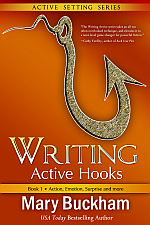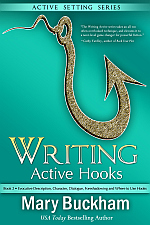We have the perfect attention-getting cover, and readers are clicking to read more. We have a great back-cover blurb, and readers are buying our story. We’re good to go, right?
Not quite. We want readers who start our story not be able to put it down. We want them to get to the end of our book and love our storytelling so much that they can’t wait to buy the next one.
In short…
- Our intriguing cover turns a browser into a shopper.
- Our interesting blurb turns a shopper into a reader.
- Our compelling writing turns a reader into a fan.
One of the ways we create compelling writing is by creating a need within our readers. Our readers need to keep turning pages to learn more, to answer their questions, to reach the happy ending, to figure out “who did it,” etc.
So a common piece of advice is to create hooks—phrases, sentences, ideas, questions, etc.—to fuel that need within readers. Today, I’m excited to welcome Mary Buckham to the blog to discuss hooks.
We benefited from Mary’s advice last year on using point of view for settings and on how to anchor settings, and now she has a new two-book series on hooks. With two books’ worth of material, it’s hard to narrow down the highlights, but Mary’s here to touch on the 9 types of hooks and to answer frequent questions about using hooks.
Also, check out the details below for a giveaway of one of her new books! Please welcome Mary Buckham! Yay! *smile*
*****
Wanted:
Writers Who Are Willing to Become Hookers!
Can you answer the following questions?
- Do you know how many hooks you need to get a reader to turn the page?
- Do you know what the most common types of hooks are for the type of book you are writing?
- Do you know where hooks must be on the page to convince a reader to buy your book?
- Do you know how many hooks are included in the following sentence?
“Kill that baby!” — Sherrilyn Kenyon — Acheron
Introduction to Hooks
If you stumbled or have no idea how to answer any of these questions, trust me, you’re not alone. All writers are told about hooks—hook your critique partners, hook an editor or agent, hook the reader—but we’re not really taught exactly how to do that.
I know when I started writing, I thought I was hooking readers, at least that was my intention, but when I heard from an early rejection letter that the editor found it easy enough to set the manuscript down, I knew I was missing the mark. So I started hunting for exactly what hooks were and how to use them better.
What I found is that there were how-to books using the word Hooks in the title—and all had something to offer—but what I wanted was a clear guideline to the use of hooks throughout a novel, where and how to use them most effectively, and why there were books I could set down easily vs. the books that kept me up long after I wanted to go to bed.
Not Sure How to Best Use Hooks? You’re Not Alone
Working with other writers in all genres, I realized I was not alone in my quest to understand the power and placement of hooks beyond the first page. Why were some hooks used in certain novels but rarely in other novels? Why could an author writing something considered slower paced still compel me to keep reading and in another genre, one I loved, did I find a story lagging?
Here’s some of what I discovered:
- Hooks are very subjective, which means some will resonate with some readers but not every reader all the time.
- Even with this subjectivity, there tend to be a total of nine universal hooks that work regardless of what we write.
- The intention of most hooks is to compel a reader to read deeper into the page, turn the page, or start the next scene or chapter.
- Hooks can be taught and learned, though they do require practice.
I discovered that hooks are meant to raise questions for a reader. The type of questions that intrigue us enough to keep reading until our curiosity is assuaged. At that point, the smart writer has threaded in additional hooks without the reader being aware that they are intentionally being guided through a book.
This was eye-opening to me, and my quest to make more writers strong hookers gelled.
Meet the Nine Universal Hooks
First step was to narrow down the nine universal hooks. Here they are:
- Action:
The type of action associated with danger and that when experienced, makes you pause and pay attention. - Overpowering Emotion:
Not the kind of emotion every page should contain, but the kind that grabs your curiosity to find out why and what happened or is happening. - A Surprising Situation:
Which means you didn’t expect that event or action or dialogue or decision to happen on the page, whether it’s the first sentence in a novel or the last in the book. - The Totally Unexpected:
This hook ramps up the Surprising Situation into something more, larger, grab-you-harder type of response in a reader. It’s the difference between knowing your sister-in-law is having an affair and discovering that she’s having that affair with your husband. - Question(s) Raised:
This is the easiest and most universal of hooks and, once you start noticing and understanding the use of hooks, is so easy to create it’s hard not to create some type of question either stated implicitly or implied. “Are you going to kill your husband?” is an explicit question raised. Hearing he was having an affair with your sister-in-law creates an implied question. - Unique Character:
Yes, all our protagonists are unique, and if the reader would only keep reading, they’d discover what we, as the author, know. But the reader won’t keep reading if you don’t continue to give them reasons, if you don’t continue to hook them until they reach the realization that you have indeed written a very unique character. - Evocative Hook:
The single most difficult hook for the average writer to identify. - Foreshadowing or Warning:
That sense that the sentence or paragraph you just read stands to cause complications, challenges and possible conflict deeper into the story, and is intriguing enough that you have to keep reading to find out what happens as a result. - Surprising or Shocking Dialogue:
This often is in tandem with the Surprising hook and the Question(s) Raised hook or in contrast to what the reader expects to hear.
Common Questions and Answers about Hooks
So now that you know the most universal and commonly used hooks, are you an official hooker?
You’re closer to that goal. But there’s more, a lot more.
Since it required two e-books for me to go into enough detail about all the ins and outs of hooks, what I’ll be able to share here is limited. But even the bare bones can be helpful in letting you know if you struggle with hooks or are one of those rare writers who know how to craft them naturally, without thinking twice.
For the rest of us mere mortals, here are a few of the most common questions asked about hooks that can help you become a stronger hooker:
Q: Can your sentence have more than one hook?
A: Yes, most opening sentences, in particular, do.
Q: How do I know how many hooks are appropriate in the key places you mention for what I’m writing?
A: By studying other novels in your genre. Especially the more recent debut authors, as the number and types of hooks used ten or twenty years ago can change.
Q: What if my novel crosses many genres? How do I focus on what hooks work best?
A: Determine what is the main focus of your story. Is it the mystery or the romance or the western element, etc.? Think in terms of the reader who wants to read what you’re writing and what attracts them most and then study and use hooks for those readers.
Q: How do I learn more about hooks?
A: Read books, especially those that have kept you up late at night reading when you wanted to go to sleep. Read them once for enjoyment then re-read to examine the key placement of hooks on the page to see what types of hooks were used and how many at these key points. The more you see hooks in action, the easier it is for you to see in your own work which hooks to apply and where.
Q: I don’t like all the kinds of hooks. Is that a problem for me as a writer?
A: No. Once you discover the types of hooks your readers respond to based on what you’re seeing in the genre you’re writing, you can focus on them. There is a problem if you love one or two kinds of hooks only, such as the evocative hook, but are trying to write to a genre that tends not to love the evocative hook as much as you might. Once you start writing for publication, you must think about your reader as well as your own preferences.
Answers to the Questions at the Opening of This Post:
1. Do you know how many hooks you need to get a reader to turn the page?
A: Depends on where in the book you are inserting the hooks and the what you are writing. As many as the type of your story requires, but no more. The number for a woman’s fiction novel will not be the same for a thriller. A romantic suspense will require more than a romantic comedy.
2. Do you know what the most common types of hooks are for the type of book you are writing?
A: Study your genre and you’ll learn this answer.
3. Do you know where hooks must be on the page in order to convince a reader to buy your book?
A: On the 1st page: the first sentence, end of the first paragraph, and end of the page at minimum. Beginning and ends of every scene and chapter, the number depends on where the scene and chapter is in your overall novel.
4. Do you know how many hooks are included in the following sentence?
“Kill that baby!” — Sherrilyn Kenyon — Acheron
A: 8.
Writing is not for wimps. If hooks do not come easily for you, don’t despair, as it is a craft element that can be learned.
Make it your goal to be a great hooker.
*****
 USA Today bestselling author Mary Buckham writes the Amazon best selling WRITING ACTIVE series for writers – WRITING ACTIVE SETTING and WRITING ACTIVE HOOKS.
USA Today bestselling author Mary Buckham writes the Amazon best selling WRITING ACTIVE series for writers – WRITING ACTIVE SETTING and WRITING ACTIVE HOOKS.
She doesn’t just teach writers though, she practices what she preaches, writing Urban Fantasy with attitude. Love romance, danger & kick-ass heroines?
Find it in her Alex Noziak or Kelly McAllister series: www.MaryBuckham.com
 About WRITING ACTIVE HOOKS BOOK 1:
About WRITING ACTIVE HOOKS BOOK 1:
Do you know what hooks can do for your novel?
- Learn to identify the first five most common types of hooks.
- Understand how to craft hooks in a consistent way and why most readers will respond to hooks.
- Grasp the intention of hooks.
- Step by step, watch sentences change from no hooks to containing multiple hooks.
Put hooks to work in your own stories with the tips and insights you’ll learn here.
 About WRITING ACTIVE HOOKS BOOK 2:
About WRITING ACTIVE HOOKS BOOK 2:
Want to engage a reader from the first page of your novel and keep them engaged?
- Move deeper into the craft of writing hooks.
- Discover the most common pitfalls when writing hooks.
- Learn to identify the four remaining hooks and how they can challenge a writer.
- Find out where hooks must be used to create a page-turning manuscript.
Examine how authors in all genres incorporate hooks into their work and how you can duplicate the process in your own manuscripts.
*****
Thank you, Mary! I had no idea there were so many kinds of hooks. *smile*
I’ve heard some people complain about hooks being too formulaic—like every chapter ending on a dun dun dun—but I think that’s more of an issue if we’re too limited in the styles of hooks we use. If we’re always ending a chapter with a dun-dun-dun dialogue line, our writing will feel predictable. So it’s great to learn about the different types of hooks so we can mix-and-match and avoid turning our writing into a cliché.
As with most writing techniques, we might not consciously include hooks while we draft. Or we might write without chapter breaks and decide where to place those breaks based on where those hooks already fall in the story. But when we’re revising and editing our work, we want to think about how we can make our hooks stronger and more compelling.
With the right knowledge, we’ll be able to make our writing compelling enough for readers to turn pages. And when they get to the end of that book, hopefully they’ll be eager for our next story. *smile*
Mary’s also doing a giveaway! She’s giving away two ebooks from her WRITING ACTIVE collection, just leave a comment before April 5th to enter. Yay!
Do you naturally include hooks when you draft, or do have to add those at a later stage? Did you know that there were so many different kinds of hooks? Do you have a favorite way of using hooks? Or is there a hooks technique you have to ensure you don’t overuse? Do you have any questions for Mary about using hooks in our writing?

